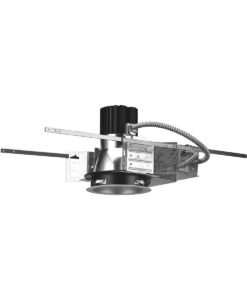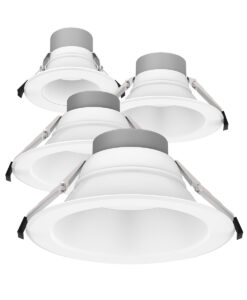Outdoor Recessed Light: Lighting Explained
Lighting plays a crucial role in enhancing the aesthetics and functionality of outdoor spaces. Among various lighting options, outdoor recessed lights have gained popularity for their sleek design and versatility. This article delves into the intricacies of outdoor recessed lighting, exploring its benefits, installation considerations, and design tips.
Understanding Outdoor Recessed Lighting
Outdoor recessed lighting, often referred to as can lights or pot lights, is designed to be installed into ceilings or walls, creating a clean, unobtrusive look. Unlike traditional fixtures that hang down, recessed lights are flush with the surface, making them ideal for modern outdoor spaces. This design not only contributes to a sleek aesthetic but also reduces the risk of accidental bumps or damage, particularly in high-traffic areas. As outdoor living spaces become more popular, the versatility of recessed lighting allows homeowners to enhance their patios, decks, and gardens with effective illumination that complements their design style.
Components of Recessed Lights
Recessed lighting consists of several key components: the housing, trim, and bulb. The housing is the part installed into the ceiling or wall and houses the electrical components. It is essential to choose a housing that is rated for outdoor use, as this ensures durability against the elements. The trim is the visible part that finishes the look, available in various styles and colors, allowing for customization to match the overall decor. Lastly, the bulb provides the illumination, with options ranging from incandescent to LED. LED bulbs are particularly favored for their energy efficiency and longevity, making them a smart choice for outdoor settings where lights may be left on for extended periods.
Types of Outdoor Recessed Lights
There are several types of outdoor recessed lights, each suited for different applications. Some common types include:
- Adjustable Recessed Lights: These lights can be tilted to direct light where needed, making them ideal for highlighting architectural features or landscaping. This flexibility allows homeowners to create dynamic lighting scenes that can change with the seasons or occasions.
- Fixed Recessed Lights: These provide a consistent beam of light and are often used for general illumination. They are perfect for pathways or entryways, ensuring safety and visibility during nighttime.
- Wall Wash Recessed Lights: Designed to cast light across a wall, these fixtures create a dramatic effect and enhance textures and colors. They can be particularly effective in illuminating outdoor art installations or textured stone walls, adding depth and character to the outdoor environment.
In addition to these types, some recessed lights come with integrated smart technology, allowing homeowners to control brightness and color temperature through mobile apps or voice commands. This feature not only adds convenience but also enhances the ambiance of outdoor gatherings, enabling users to set the perfect mood with just a few taps on their devices. Moreover, the use of motion sensors in some recessed lighting options can provide added security, automatically illuminating areas when movement is detected, thus deterring potential intruders and ensuring safety for family and guests alike.
Benefits of Outdoor Recessed Lighting
Choosing outdoor recessed lighting offers numerous advantages that can transform any outdoor area. From aesthetics to functionality, these lights serve multiple purposes.
Aesthetic Appeal
One of the most significant benefits of recessed lighting is its ability to enhance the visual appeal of outdoor spaces. By providing subtle illumination, recessed lights can highlight architectural features, landscaping, and outdoor living areas without overwhelming the design. This understated elegance creates a sophisticated ambiance that can elevate any outdoor setting.
Space-Saving Design
Unlike traditional lighting fixtures that can take up space and obstruct views, recessed lights are installed flush with ceilings or walls. This space-saving design is particularly beneficial for smaller outdoor areas where every inch counts. The unobtrusive nature of recessed lighting allows for a more open and airy feel, making spaces appear larger and more inviting.
Versatility in Application
Outdoor recessed lights are incredibly versatile and can be used in various applications. Whether illuminating a patio, walkway, or garden, these lights can adapt to different needs. They can be strategically placed to create layers of light, enhancing safety and visibility while also setting the mood for evening gatherings.
Installation Considerations
While outdoor recessed lighting offers many benefits, proper installation is crucial for optimal performance. Several factors must be considered to ensure safety and effectiveness.
Choosing the Right Location
Before installation, it is essential to determine the best locations for recessed lights. Consider areas that require illumination, such as walkways, staircases, and seating areas. Additionally, think about the overall design and how the lights can enhance the space. Proper placement can create a balanced lighting scheme that highlights key features while providing adequate visibility.
Weather Resistance
Outdoor recessed lights must be designed to withstand the elements. Look for fixtures rated for wet or damp locations, ensuring they can handle exposure to rain, snow, and humidity. Weather-resistant materials, such as aluminum or stainless steel, are ideal for outdoor applications, providing durability and longevity.
Electrical Considerations
Electrical safety is paramount when installing outdoor recessed lighting. It is advisable to consult a licensed electrician to ensure compliance with local codes and regulations. Proper wiring and circuit considerations are essential to prevent overloads and potential hazards. Additionally, using LED bulbs can help reduce energy consumption and minimize heat output, making them a safer choice for outdoor lighting.
Design Tips for Outdoor Recessed Lighting
To maximize the impact of outdoor recessed lighting, consider these design tips that can enhance both functionality and aesthetics.
Layered Lighting
Layering different types of lighting can create depth and dimension in outdoor spaces. Combine recessed lights with other fixtures, such as wall sconces or pendant lights, to achieve a balanced lighting scheme. This approach allows for flexibility in adjusting the mood and functionality of the space, catering to various activities and occasions.
Highlighting Features
Use recessed lights to draw attention to specific features in your outdoor area. For instance, strategically placing lights to illuminate trees, sculptures, or architectural elements can create stunning focal points. This technique not only enhances the visual appeal but also adds a sense of drama and intrigue to the landscape.
Creating Pathways
Outdoor recessed lights can be effectively used to create safe and inviting pathways. Installing lights along walkways or driveways provides essential illumination, guiding guests safely through the space. Consider using lower wattage bulbs for a soft glow that enhances visibility without being harsh or blinding.
Energy Efficiency and Sustainability
As environmental concerns continue to rise, energy efficiency has become a priority in outdoor lighting design. Outdoor recessed lights, particularly those using LED technology, offer significant advantages in this area.
Benefits of LED Technology
LED bulbs are known for their energy efficiency, consuming significantly less power than traditional incandescent or halogen bulbs. This efficiency translates into lower energy bills and a reduced carbon footprint. Additionally, LED bulbs have a longer lifespan, meaning they need to be replaced less frequently, contributing to less waste over time.
Smart Lighting Solutions
Integrating smart technology into outdoor recessed lighting can further enhance energy efficiency. Smart lighting systems allow users to control their lights remotely, set schedules, and adjust brightness levels based on specific needs. This level of control not only improves convenience but also optimizes energy usage, ensuring lights are only on when needed.
Solar-Powered Options
For those looking to embrace sustainability, solar-powered recessed lights are an excellent choice. These lights harness solar energy during the day and automatically illuminate at night. While they may require a higher initial investment, the long-term savings on energy costs and the positive environmental impact make them a worthwhile consideration.
Common Mistakes to Avoid
When planning and installing outdoor recessed lighting, certain pitfalls can diminish the effectiveness of the lighting scheme. Being aware of these common mistakes can help ensure a successful installation.
Overlighting or Underlighting
Striking the right balance between too much and too little light is crucial. Overlighting can create harsh shadows and glare, while underlighting can lead to safety hazards and an uninviting atmosphere. Consider the purpose of each area and adjust the number and wattage of lights accordingly to achieve the desired effect.
Ignoring the Landscape
Failing to consider the surrounding landscape can result in a disjointed lighting scheme. It is essential to integrate recessed lights with the natural features of the outdoor space. Take into account the height of plants, the layout of pathways, and the overall design to create a harmonious look that enhances the environment.
Neglecting Maintenance
Outdoor recessed lights require regular maintenance to ensure optimal performance. Neglecting to clean fixtures or check for damage can lead to reduced efficiency and a shorter lifespan. Regularly inspect lights for dirt, debris, and wear, and replace bulbs as needed to maintain a well-lit outdoor area.
Conclusion
Outdoor recessed lighting is a powerful tool for enhancing the beauty and functionality of outdoor spaces. With its sleek design, versatility, and energy efficiency, it offers numerous benefits that can transform any area. By understanding the components, installation considerations, and design tips, homeowners can create stunning outdoor environments that are both inviting and practical.
Whether illuminating pathways, highlighting features, or creating a cozy atmosphere for gatherings, recessed lights can elevate outdoor experiences. As technology continues to evolve, embracing energy-efficient solutions like LED and smart lighting will not only enhance aesthetics but also contribute to a more sustainable future.
Ultimately, outdoor recessed lighting is more than just a practical solution; it is an opportunity to express creativity and enhance the enjoyment of outdoor living spaces.
Illuminate Your Outdoor Space with Expertise from PacLights
Ready to transform your outdoor areas with the elegance and efficiency of recessed lighting? At PacLights, we’re committed to guiding you through every step of the process. Our high-quality LED lighting solutions are tailored to fit both commercial and industrial needs, ensuring your outdoor spaces shine with optimal brightness and style. Don’t hesitate to Ask an Expert at PacLights for personalized advice on creating the perfect lighting design for your space.





Disclaimer: PacLights is not responsible for any actions taken based on the suggestions and information provided in this article, and readers should consult local building and electrical codes for proper guidance.